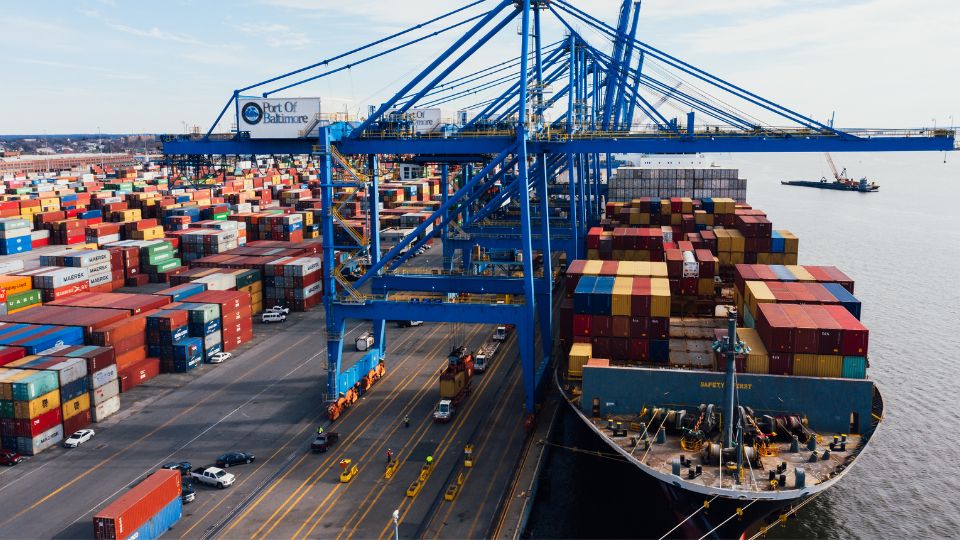Spot rates in shipping are one of the biggest challenges for every business. Simply because they often change dramatically.
Imagine you’re shipping a container of smart TVs from China to the U.S., and it needs to be delivered within a week. Since you are looking for a quick option, you book the next available vessel.
But here’s the catch: without knowing the spot rate, you risk overpaying.
Spot rates can be both an opportunity and a challenge. They might help you save on costs when demand is low or lead to unexpected expenditures during high-demand periods.
Hence, understanding how spot rates affect freight pricing is super important. It will help you make informed decisions and optimize your shipping budget.
In this article, we’ll explore spot rates, how they are determined, and their impact on total freight pricing.
Let’s first understand what a spot rate is and why it is important.
What is a Spot Freight Rate?

A spot freight rate is the cost you pay for shipping your cargo at the time of booking. Unlike a long-term contract, this rate is valid only for a specific shipment.
Spot rates are highly dynamic and can change unpredictably. These rates are usually set for individual shipments. They can fluctuate based on changing market needs, fuel prices, and availability of container space.
Let’s look at what makes spot rates unique:
- Spot rates often change daily.
- Reflects the current market trends and expectations.
- Includes basic freight charges and standard surcharges.
- It is not bound by any long-term contract.
- It doesn’t have any limitation on maximum volume.
- It is valid for a short time, usually for time-sensitive or urgent bookings.
Now, let’s understand how these rates work in everyday shipping situations.
How do Spot Freight Rates Work?
Spot freight rates follow a basic supply-and-demand principle. These rates represent the current market price for moving your cargo immediately, within the set time for a specific shipment only.
The spot freight rate includes two key components, which are:
1. Base Freight Rate: This is the basic cost that shipping lines charge for the transportation of your goods.
2. Surcharges: It is the extra fees added to your base shipping rate. It includes specific costs for fuel price, peak season demands, or special handling requirements.
Some of the most common surcharges are:
a) Bunker Adjustment Factor (BAF)
Also known as a Fuel surcharge, BAF is the fee charged for the amount of fuel used by the ship. The shipping companies add this surcharge to the total freight rates, taking into account the changing global fuel prices.
b) Currency Adjustment Factor (CAF)
Surcharge that accounts for exchange rate fluctuations of currencies. It is charged to cover losses during currency conversions.
c) Peak Season Surcharge (PSS)
An additional fee is charged for shipping during peak-demand periods to manage limited shipment capacity, known as Peak Season Surcharge.
d) Emergency Bunker Surcharge (EBS)
This is the variable or last-minute fee added on top of BAF to cover unexpected increases in fuel prices. It is usually paid at the port by the seller of the cargo.
e) Terminal Handling Charges (THC)
These are the fees charged for handling cargo and loading or unloading containers at port terminals.
f) Documentation Fees
The administrative fees for processing shipping documents, bills of lading, and customs paperwork are included in the documentation fees.
All these key components are combined to calculate Spot freight rates.
In layman’s terms, it is calculated based on the following formula:
| Base Rate + Surcharges + Local Charges + Additional Services = Total Spot Rate |
With this understanding, let’s compare it against contract rates.
Freight Spot Rates vs. Contract Rates
Understanding the difference between freight spot rates and contract rates is key to managing shipping costs effectively. Both these rates are useful, but they represent two different pricing structures, each serving different shipping needs and strategies.
Here’s a comparison of both rates to help you choose the right option.
| Spot Rates | Contract Rates |
| Booked for immediate or short-term shipping needs. | Fixed freight price agreed for a set period, usually a year. |
| Valid for the designated shipment only. | Guaranteed for space and equipment availability. |
| More risky but offers potential cost savings, especially when market prices drop. | More stable for overall budgeting. |
| Change daily with the fluctuating market conditions. | Better for consistent shipping volumes. |
To sum it up, if you have regular, high-volume shipments, contract rates are the option for you. Whereas, if you have small cargo and infrequent shipping schedules, you can find better value from spot rates.
Advantages of Shipping Spot Rates
Listed below are some of the key benefits of spot rates:
- No Long-term Contract: Spot rates are not bound by any long-term contract. This means you have the freedom to choose and book the shipments based on your customers’ needs. You also don’t need a set volume or a certain number of shipments to bargain the best spot rates.
- Flexibility to Switch Carriers: You can switch carriers, routes, or even delivery dates as and when your business needs change.
- Access to last-minute deals: When shipping lines need to fill container space quickly, they offer better freight rates at lower costs. You can take advantage of these last-minute deals and grab cheaper spot rates.
- Ability to test different services: You can test and compare spot rates across various service providers. You can also evaluate rates from multiple shipping lines and then lock in a deal. This helps you identify cost-effective and efficient transportation options.
- Adjust to Market conditions: With spot freight rates, you can adjust your schedule based on customer needs. You can also make investments at lower rates and take advantage of market drops.
But what exactly fluctuates the spot rates? Let’s find out.
Factors Influencing Spot Freight Rates

Let’s understand the factors that influence spot rates one by one:
1. Market Demand and Capacity
The rates directly depend on the cargo volumes and the available vessel’s capacity.
In the seasonal periods, the demand for spot rates rises because the shipping lines increase the price of their freight rates. In contrast, spot rates are lower because of increased supply and an inadequate number of carriers to fill the available space.
2. Global Economic Conditions
Volatility in the economy, trade policies, and international market trends greatly influence the spot rates.
Economic growth leads to higher demand and higher rates. On the other hand, when the economy slows down, not everyone opts for shipping. During this time, carriers lower their rates to encourage more business.
Trade imbalances between regions also influence pricing structures. Carriers often charge less for routes with less cargo or traffic.
3. Fuel Costs and Surcharges
Bunker fuel prices are a key component of shipping costs. BAF is linked to oil prices. When oil prices change, carriers adjust BAF and affect spot rates.
Carriers adjust these surcharges regularly based on changing fuel prices to maintain profitability.
4. Seasonal Factors
Peak shipping seasons, holidays, and major industry events also cause significant rate variations.
Similarly, predictable demand patterns such as agricultural harvests, manufacturing cycles, and retail peak periods also influence pricing.
5. Equipment Availability
The availability of shipping equipment, such as containers or vessels, plays a key role in determining spot rates.
When limited space is available, the demand for equipment increases, leading to higher spot rates. On the other hand, when the containers are available in plenty, the demand for spot rates decreases.
Trade route imbalances can also lead to equipment shortages in certain regions. This leads to higher costs for repositioning equipment and higher spot rates.
6. Port Congestion and Delays
Congestion at busy ports delays container returns. This shortage of equipment leads to an immediate spike in spot rates.
Different variables like reduced port efficiency, equipment shortages, and operational delays force carriers to make costly schedule changes. As a result, shipping lines charge double their standard rates during severe port congestion periods.
With this information, let’s explore which tools you can use to manage spot rates in shipping.
Essential Tools for Spot Freight Rate Management

Managing spot freight rates in these dynamic market conditions is like having a GPS for shipping. With the right tool, management becomes easier and better.
Here are the essential tools that can help improve your rate management.
1. Rate Comparison Platforms
Popular rate comparison platforms like FreighPOP and Shipwell provide online tools or software that allow:
- Rate comparison across multiple carriers instantly.
- Real-time data to identify cost-effective options.
- Spot the best deals on your routes with multiple carrier options.
- Track price trends over time.
- Get alerts when rates drop on your preferred routes.
- Identify and analyze patterns from historical data to optimize the shipping budget.
2. Market Monitoring Tools
These monitoring tools help businesses stay competitive and make informed logistics decisions.
You can stay ahead of market changes with tools that:
- Track and forecast global shipping trends.
- Analyze real-time updates on changing market conditions.
- Monitor shipping capacity levels.
- Send alerts to notify of port congestion.
- Follow fuel price changes.
- Predict market supply and demand fluctuations.
ShipBob, project44, and AfterShip are some of the popular names of market monitoring tools in shipping.
3. Booking Systems
Booking Systems are digital platforms that allow you to view, reserve, and manage bookings for shipments, container space, or modes of transportation, all in one place.
ShipStation, Shippo, and EasyShip are some of the widely used platforms for booking systems.
With these systems, you can better use resources and streamline daily operations.
In short, these modern booking systems offer:
- One-click booking options from multiple carriers
- Instant confirmation
- Real-time access to equipment availability
- Digital documentation
- Rate lock features
- Integrated payment processing
- Options for modifying or canceling reservations
- Easy to navigate, user interface.
4. Tracking Solutions
Digital freight tracking solutions allow businesses to regularly monitor the location, status, and progress of their shipments. These platforms provide real-time visibility and ensure timely deliveries. Examples of some popular shipment tracking solutions include SeaRates ERP, 17TRACK, and Ship24.
These platforms offer:
- Real-time updates for cargo.
- Container tracking, from the time of dispatch to delivery.
- Automated notifications for both delays and deliveries.
- Estimated Time of Arrival (ETA) predictions.
- Valuable data on transit times, route optimization, and delivery performance.
Before investing in a technology, first analyze your business needs. Then, assess how well these tools integrate with your existing systems. Based on this evaluation, you can opt for the right tool.
Conclusion
Spot rates play a crucial role in managing shipping and transportation costs. To optimize these rates, you need to:
- Monitor market trends and fluctuations to anticipate rate changes
- Maintain good relations with service providers
- Use digital tools to track and compare the best rates
Staying updated on market fluctuations and adopting a flexible approach will always reap greater benefits.
| Do you want to save costs and improve the efficiency of your freight-forwarding operations? Let SeaRates ERP give you the power and flexibility to manage your freight-forwarding operations. Get in touch to learn more. |
Frequently Asked Questions
1. How long is a spot freight rate quote valid?
Spot freight rate quotes have very short validity periods, usually 24-48 hours. Always check the expiration time on your quote, as rates can change daily based on changing market conditions. It’s also important to check and confirm rates before booking, especially if working with a quote that’s more than a day old.
2. What exactly does a spot freight rate quote include?
A quote for spot freight rate includes:
- Base ocean/air freight rate
- Standard carrier surcharges
- Fuel adjustment factors (FAF)
- Basic terminal handling charges or THC
Always check the inclusions and exclusions in your quote to understand what is covered and what isn’t.
3. When should I choose spot rates over contract rates?
You can choose spot rates when:
- You have irregular shipping patterns
- Your volume is too low for contract rates
- Market rates are lower than contract rates
- You are looking for flexible carrier options
- In case of urgent or unexpected shipments
- You’re testing new routes or markets
4. How can small businesses get better spot freight rates?
Small businesses can improve their spot rates by:
- Using digital rate comparison platforms like SeaRates ERP.
- Building relationships with multiple freight forwarders.
- Booking during off-peak seasons.
- Consolidating shipments when possible.
- Using rate management tools for better market visibility.
5. Why do spot freight rates fluctuate so much?
Spot rates fluctuate due to several key factors:
- Supply and demand changes in the market
- Seasonal shipping patterns
- Fuel price variations
- Port congestion and delays
- Equipment availability
- Global events and trade imbalances
Understanding these factors can help you plan your shipments and budget more effectively.


